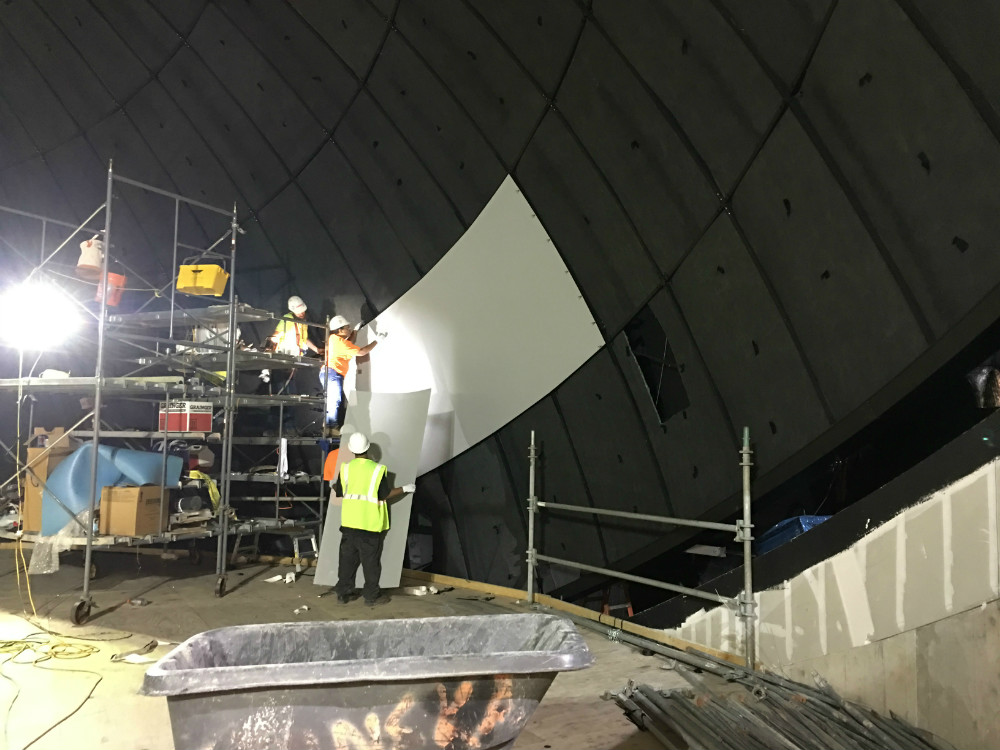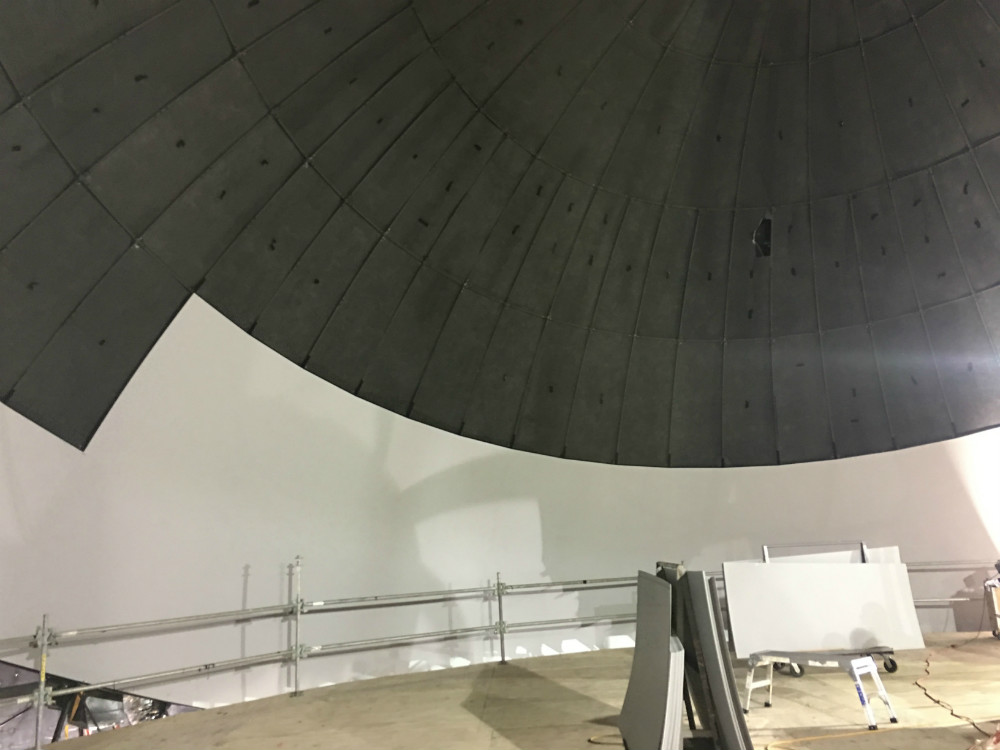
Who doesn’t love being swept away through light years of outer space to far-off nebulae, stars and sunsets on other planets? That is what the Frost Planetarium is all about. However, to create these dazzling immersive experiences, our planetarium system must have precise engineering, thoughtful design and cutting-edge technology. We’re taking you behind the scenes to see how the team at Frost Science is ensuring that the Frost Planetarium, opening spring 2017, will be one of the most advanced planetariums in the world.
Let’s start from the ground up. The seating of the Frost Planetarium is raked stadium-style, but more importantly, the dome is tilted forward at 23.5 degrees, which means the screen not only wraps around your field of vision, but above it and below it. This angle of sight in relation to the rounded screen gives you a feeling of flying, as clouds or asteroids whisk underneath you, above you and on all sides.
The extreme width and depth of the dome screen requires several projectors working in unison to create one cohesive high-resolution image. The Sky-Skan projection system uses six Christie Mirage 304K projectors, each projecting a different part of the fulldome image to different parts of the screen, and blending them together to form seamlessly sweeping views of the planet or galaxy you’re traveling to. The projectors achieve a 16-million-color palate and together produce 8K resolution. They also process at the highest possible rate and are capable of true 120Hz to ensure stunning color reproduction and image quality. The system also allows Frost Science to show 3D theater presentations. The projectors use extremely rapid filter movements to create two images that your eyes then merge together with the use of the 3D glasses.
Profound advancements in visual digital technology have really changed what planetariums can do. Our software, produced by Sky-Skan, allows us to take you anywhere in outer space you want to go, from the sky above Miami to the edge of the known universe. A planetarium host can move a mouse and surround you with a preview of tonight’s night sky, or pull out so you can see the Earth from any angle. As you look at Earth from outer space, the host can show you the exact path of the next solar eclipse (taking place on August 21, 2017!), then zoom in to show you what the full eclipse will look like along that path, or from Miami, where the sun will peek out from behind the moon. The software’s map of the universe allows it to provide accurate views from anywhere. The host can sweep you to the surface of Mars for a sunset, then pull out again to see the solar system, and the real-time path of each planet’s orbit. Pull out again and leave the Milky Way on your way to other galaxies, all with the click of a mouse. The system automatically connects to global science data and updates itself with the latest information about the universe, so there will always be something new to see and learn.
To give you the ultimate immersive experience, we also had to be thoughtful about materials. Modern projectors provide amazing imagery, but they give off more light, revealing seams in standard projection surfaces. Our solution is an aluminum projection surface made up of hundreds of perforated panels that join together with NanoSeam technology. The panels fit together so well that the surface appears seamless, and has been described as sitting inside a giant eggshell. The reasons for the perforations are twofold: air from the cooling system flows through the screen and circulates throughout the space, and much of the high-tech sound system sits hidden behind the screen.
A 17-channel surround sound speaker solution gives a three-dimensional depth to the audio of the planetarium. Each loudspeaker has special technology to dramatically improve high frequency sound quality and decrease distortion. These speakers are also capable of producing exceptional sound quality at up to 143dB. Frost Planetarium is the first domed theater in the world to utilize this technology. Deep low-end sound comes from four JBL 5628 Cinema Subwoofers capable of 130dB per cabinet. Amplifiers deliver over 40,000 watts to the speakers. Together the system produces a high-power, low-distortion 12.1 surround field.
Soundproofing is also crucial. After we built the concrete dome we put down a layer of soundproofing, then installed speakers, all before hanging the aluminum screen. This dark layer also absorbs light that might cast through the perforations, preventing it from reflecting and hampering image quality.
Right now we’re in the process of having our director of planetarium and box office operations, Mark Bennett, and our curator of astronomy, Dr. Jorge Perez-Gallego, train on the Sky-Skan software, and prototype virtual journeys through outer space. They’re toying with ideas, and writing scripts as to where to take audiences, and how best to use the planetarium to teach about the wonders of the universe. In fact, Perez-Gallego recently traveled to Warsaw, Poland to partake in the International Planetarium Society’s bi-annual conference, where some of the best minds in the planetarium business convene to share ideas, insights and creative work. Now that we have air conditioning in the space, we’ve hung the speakers and are completing the placement of the screen. It’s all part of this engineering, technology, design and creativity that goes into making the 67-foot diameter full-dome screen the perfect surface on which to view the astounding beauty of outer space.

